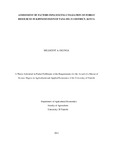Assessment of factors influencing utilization of forest resources in Kipini Division of Tana Delta district, Kenya

View/
Date
2013Author
Olunga, Millicent A
Type
ThesisLanguage
enMetadata
Show full item recordAbstract
Forest resource utilization poses a major challenge to the balance between fragile
ecosystems and impoverished populations. Many developing economies have majority of
their populations living in rural areas where they mainly depend on agriculture or on natural
resources and ecosystem services for a living. With the increase in population,the demand for
the forest resources and the resultant degradation are expected to increase. Many benefits can
be derived from forest conservation initiatives including carbon offsets, seedlings sale and
reduction in distances covered to access raw material for wooden handcrafts. Yet incidences
of forest destruction by local communities are very common. This study examined the
awareness of forest benefits, factors that influence utilization of forest products and attitudes
of households towards conservation of forests. The analysis was conducted using different
regression models. The Zero Truncated Poisson model was used to assess awareness of forest
benefits while the Logit and Negative binomial models were used to examine use and
intensity of use of forest products respectively. Descriptive and factor analysis methods were
used to assess the attitudes of local communities towards forest conservation. The study used
data collected from 150 households through personal interviews using pre-tested
questionnaires. The study was conducted in Kipini division of Tana Delta district. The
division has three types of forest management regimes namely, private conservancy,
community and government or, more specifically, the Kenya Forest Service (KFS). The study
finds average level of awareness of both direct and indirect forest benefits. Results indicate
that awareness of benefits was highest in the KFS regime. The Zero Truncated Poisson
regression results show that income, gender, farm size and management regimes influence
awareness of forest benefits. The proportion of the respondents using products from the forest
was 51%. Logistic regression results show that income, distance to the main road, regime and
the occupation of the household head influence use of forest products while results from
Negative Binomial regression showed that intensity of use of forest products is influenced by
regime, occupation of the household head, income and distance to the main road. Lastly, the
results of the descriptive and factor analysis indicate that the local community has negative
attitude towards conservation of the forests across the three regimes. The implication of the
findings is that forest conservation can be enhanced by; (i)creating awareness of the direct
and indirect benefits of forest conservation using easy to understand approaches such as
educational tours, introduction of school clubs such as 4K clubs, model/demonstration farms,
and promotional products and training (e.g. energy saving jikos); (ii) investing in
infrastructure, particularly all-weather roads that will open up the area to investment by other
sectors that will in turn create multiplier effects; (iii) investing in sensitization and training on
commodity value addition and access to credit for projects from micro-credit institutions and
government initiated funds such as youth and women development enterprise fund that will
generate extra income (iv) encouraging effective community policing and community forest
associations (CFAs) to guard forest borders.
Citation
Master of Science Degree in Agricultural and Applied EconomicsPublisher
University of Nairobi Department of Agricultural Economics
